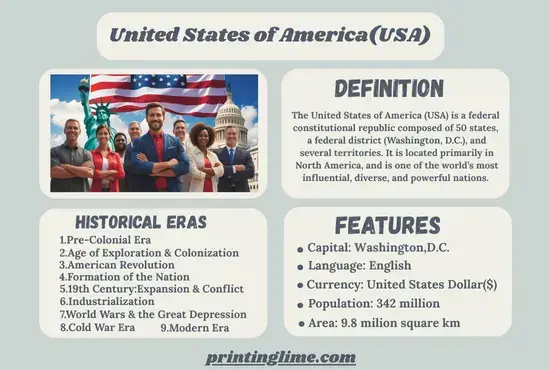“United States of America“, is the most global dominent country of the World. It is commonly known as “America“, and is abbreviated as “USA“. It is located in the North of Continent America, and is surrounded by Canda in the North, Mexico in the South, Atlantic Ocean in the East, and Pacific Ocean in the West.
It comperises of total 50 states with Washington,D.C. as federal capital. While, it is the 3rd most populated country of the World with 3rd largest land area in the World. According to U.S Census Bureau, USA has over over 342 million people in 2025.
History of United States of America(USA)
History of United States can be divided into following historical eras, that not only shape the America as Federal Republic, but influence the whole World socially, politically, and also economically.
- Pre-Colonial Era (Before 1492)
- Age of Exploration & Colonization (1492–1776)
- American Revolution (1775–1783)
- Formation of the Nation (1783–1800)
- 19th Century: Expansion & Conflict (1800–1900)
- Industrialization & Rise as World Power (1870–1917)
- World Wars & the Great Depression
- Cold War Era (1947–1991)
- Modern Era (1991–Present)
Pre-Colonial Era (Before 1492)
First Era of the United States history can be refered to as “Pre-colonial Era”, because during this era, only indigenous people were inhabited on the land of America. These people have different and rich civilizations.
Scholars estimated that first people arrived in North America from Siberia via Bering Land Bridge.These people spread throughout the continent and spread distinct languages, cultures, and lifestyles throughout the continent.
The people of Inuit and Aleut from Arctic and Subarctic region inhabited the harsh and cold region the harsh and cold regions of Alaska and Northern Canada. Due to extreme weather conditions, they totally depended on natural resources. To fullfill food, clothing, tool, and shelter requirements, they heavily did fishing, whaling, and hunting seals, walruses, and carribou. These people are so skilled and used these animals such that no part of their body went to waste.They lived in compact snow-based igloos during winters, and in sod houses during other seasons.They developed efficient tools such as dog sleds for overland travel and kayaks for navigating Arctic waters.
The coastal region of present day Washington, Oregon, and British Columbia was inhabited by the people of NorthWest Coast, such as Haida,Tlingit, and Chinook. This area had very dense forest alongwith deep ocean. The ocean fulfilled the food requirements by providing a huge supply of fish, especially salmon, whales, seals, and shellfish. While people used massive red cedar tree to build large rectangular plank houses. These people developed very rich artistic traditions, and are responsible for developing distinctive indigenous societies in North America.
Chumash and Miwok tribes inhabited the coastal as well as inland areas of California. These People had 100 distinct tribes and languages, and generally adapted local environment by living in small and self-sufficient villages.
The people of Chumash heavily relied on Pacific Ocean, while Miwok people relied on river and forest resources. However, all the inhabited people of California had excellent skill of weaving designed baskets with native grasses and plant fibers. These weaved baskets were used for storage, cooking, and ceremonial purposes, and represented the functional and artistic talent of these people.
The present day Arizona, New-Mexico, Colorado, and parts of Utah and Texas, were inhabited by the Southwest people of Hopi, Navajo, and Apache. These people started to live in cliff dwelling structures that were made up with stone, and mud plaster. Agriculture was center of their lives, despite of scarcity of water. They harvested staple crops,i.e; corn, beans, and squash (generally called as ” three sisters”, through dry farming. They created sky-based calendars aligned with solstices and celestial movements to guide agricultural and ceremonial events.
The vast grassland area from Canada to Texas, was inhabited by the Sioux, Cheyenne, and Comanche tribes. Basically, they were nomandic or semi-nomadic, and heavily relied on bison for food, clothing, tools, and shelter. Generaly, they lived in cone-shaped tents, called “tipis”. These tents were made up of wooden poles and bison hides, and werevery beneficial for their mobile lifestyle, because they could be quickly assembled or dismantled.
Iroquois, Algonquian, and Shawnee tribes people started to live in the forested regions of the northeastern United States and Southeastern Canada.As these areas had dense woodlands, rivers,and lakes, so these tribes developed a balanced blend of agricultural, hunting, and fishing. They also cultivated “Three Sisters”, corn, beans, and squash. Moreover, they hunted deer, bear, and small game alongwith fishing in large rivers and lakes.
However, people of various tribes lived in different types of houses depended on the region and cultural values.For example, the people of Iroquois built large, communal long houses, because they had extensive families. These houses are made of wood and bark. While people of Algonquian tribe lived in dome-shaped huts, called “wigwams”, that were from wooden frames and covered with bark or mats.
The forested fertile area of Southeastern United States was inhabited by the Cherokee, Creek, Choctaw, and Natchez tribes.Generally, these tribes were Mississipian decendants, and built large, complex towns. These towns centered around earthern mounds, that served ceremonial, political, or burial purposes and reflected a highly organized society. These people grew crops like corn, beans, squash, and sunflowers. Moreover, they had very clear division between elites, and commers.


